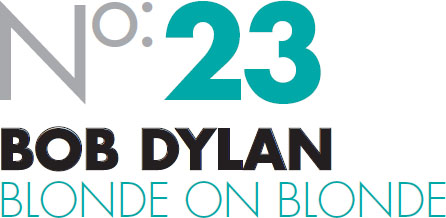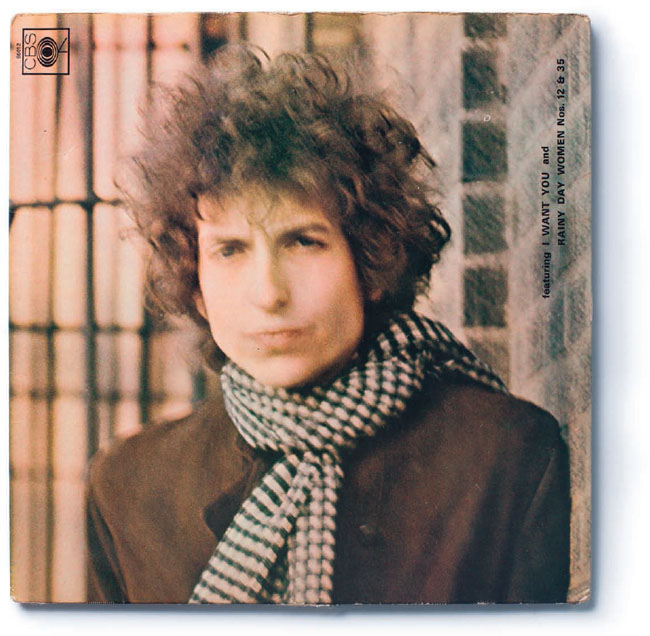
Columbia
Produced by Bob Johnston
Released: May 1966
TRACKLISTING
01 Rainy Day Women #12 & 35
02 Pledging My Time
03 Visions of Johanna
04 One of Us Must Know (Sooner or Later)
05 I Want You
06 Stuck Inside of Mobile with the Memphis Blues Again
07 Leopard-Skin Pill-Box Hat
08 Just Like a Woman
09 Most Likely You Go Your Way and I’ll Go Mine
10 Temporary Like Achilles
11 Absolutely Sweet Marie
12 4th Time Around
13 Obviously 5 Believers
14 Sad Eyed Lady of the Lowlands
‘T he closest I ever got to the sound I hear in my mind was on the Blonde on Blonde album. It’s that thin, that wild mercury sound. It’s metallic and bright gold with whatever that conjures up. That’s my particular sound.’ This is an often-quoted line from Bob Dylan because Blonde on Blonde sounds absolutely unlike any record before or since.
‘Like a Rolling Stone’ was a breakthrough single in mid-1965. By the end of the year Dylan had an even more complex song as the heart of what would be his third album in a year. Widely considered one of Dylan’s masterpieces, ‘Visions of Johanna’ captures the atmosphere of New York after midnight, mixing surreal images (‘the ghost of electricity howls in the bones of her face’) with specific scenes; the song is very clear in its intent but the meaning remains as elusive as Cocteau’s Orphee or Picasso’s Les Demoiselles d’Avignon. It was exactly at this point that rock & roll ceased being a hybrid of popular music styles and became something else.
Producer Bob Johnston suggested that Dylan record in Nashville. ‘While the rest of the world was doing an album with [the idea that] the more musicians they could get, the better it was,’ said Johnston. ‘We went in with four people … in the middle of a psychedelic world!’

In February 1966 Dylan and pals Al Kooper and Robbie Robertson flew to Nashville where session musicians Charlie McCoy (guitar, bass), Wayne Moss (guitar), Joe South (bass) and Kenny Buttrey (drums) finally nailed ‘Visions of Johanna’. The key to the recording was to be able to play live in the studio and keep up with Dylan: ‘I told everybody if they quit playing they were gone,’ said Johnston. ‘If you quit with him you’ll never hear that song again.’ Dylan disliked overdubbing, which required McCoy to play both bass and trumpet simultaneously on one song. Six songs were cut in one 13-hour session.
Then there was the track ‘Sad Eyed Lady of the Lowlands’. When the session started at 6pm Dylan hadn’t finished the lyric. The musicians killed time until 4am when he was ready. He showed the band the chords and they started. ‘After the second chorus starts building and building like crazy, and everybody’s just peaking it up ’cause we thought, Man, this is it … This is gonna be the last chorus and we’ve gotta put everything into it we can,’ recalled Kenny Buttrey. ‘And he played another harmonica solo and went back down to another verse and the dynamics had to drop back down to a verse kind of feel … After about ten minutes of this thing we’re cracking up at each other, what we were doing? I mean, we peaked five minutes ago. Where do we go from here?’ The 11-minute track would take up one side of the double vinyl album.
Between these epics, Dylan included some of his funniest songs (‘Rainy Day Women #12 & 35’, ‘Leopard-Skin Pill-Box Hat’), his most tender love songs (‘I Want You’, ‘Just Like a Woman’) and his most accessible songs (‘Pledging My Time’, ‘Absolutely Sweet Marie’). Blonde on Blonde bore plenty of traces of Dylan’s life then – his recent marriage to Sara Lownds, the birth of their son Jesse, mixing with the beautiful and damned New York bohemians, the amphetamines and heroin, hanging with Allen Ginsberg and the literary cognoscenti and the craziness of his concerts. In an interview shortly before the album came out the interviewer inevitably came to the issue of what Dylan’s songs were ‘about’. ‘I do know what my songs are about,’ the songwriter laughed. ‘Some are about four minutes; some are about five, and some, believe it or not, are about eleven.’